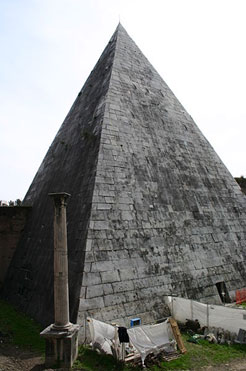
You may know that the volume of a prism is calculated by determining the area of the base and then multiplying that area by the number of layers required to build the height of the prism.
For the prism shown at right, the base has an area of 12 square units. Since the height of the prism is 5 units, there are 5 layers required to build the full prism, so the volume of the prism is 12 × 5 = 60 cubic units.
The area of a triangle is 1 over 2 1 2 the area of a rectangle, the volume of a triangular prism is 1 over 2 1 2 the volume of a rectangular prism with the same dimensions.


Source: 6276 - Roma - Piramide di Caio Cestio - Foto Giovanni Dall'Orto - 31-Mar-2008, Giovanni Dall'Orto, Wikimedia Commons
In this lesson, you will extend what you may know about volume to pyramids. A pyramid is a three-dimensional figure that, unlike a prism, only has one polygonal base. The vertices of the base are joined by segments creating lateral faces shaped like triangles that meet at one point above the base of the pyramid. That point is called the vertex of the pyramid. You may also see that point called the apex of a pyramid.
For example, the Pyramid of Cestius, in Rome, Italy, is an example of a pyramid with a rectangular base. You can see in the picture that the lateral faces are triangles, and that the edges of the lateral faces all meet at one point at the top, or vertex, of the pyramid.